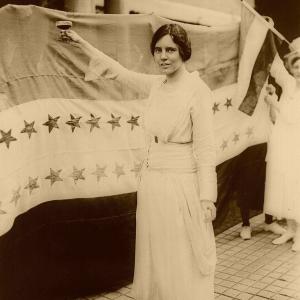Alice Paul

Early Life
Born on January 11, 1885, in Mount Laurel, New Jersey, Paul was the oldest of four children of Tracie Parry and William Paul, a wealthy Quaker businessman (Lunardini, 2013). Paul’s parents embraced gender equality, education for women, and working to improve society. Parry was an avid suffragist and attended women’s suffrage meetings hosted by their neighbors with a young Paul alongside her. Paul’s parents raised her in the Hicksite Quaker tradition that supported gender equality (Lunardini, 2013; University of Pennsylvania, 2020). William Paul bought 117 acres in New Jersey to develop it into a working farm he later named Paulsdale. While he hired people to work the farm, all four Paul children were expected to work on the farm to reinforce the Quaker teachings of the value of work and to be close to nature (Lunardini, 2013).

Above: Alice Paul Graduate Portrait (University of Pennsylvania)
Education and England
Paul attended Swarthmore College, a Quaker school cofounded by her grandfather and abolitionist and suffragist Lucretia Mott, where she graduated with a biology degree in 1905. Paul chose biology as a course of study to expand her knowledge base and was quoted as saying, “This is the only way I will ever learn about [science]” (Lunardini, 2013). Following her time at Swarthmore, she attended the New York School of Philanthropy (now Columbia University) and received a Master of Arts degree in sociology in 1907. Paul began pursuing a PhD at the University of Pennsylvania. Still, she put the program on hold upon learning of her nomination from an unknown party for a fellowship at the Quaker school in Woodbrooke, England (Lunardini, 2013). The Woodbrooke School allowed Paul to explore topics she loved, such as economics and sociology, and it was here that Paul took additional classes at the University of Birmingham (Lunardini, 2013). The classes at the University of Birmingham proved to be the defining moment in Paul’s life, when she experienced a lecture from prominent activist Christabel Pankhurst (Lunardini, 2013). This event marked Paul’s first encounter with the Women’s Social and Political Union (WSPU) (Winslow, 2025). Not long after, Paul met fellow American Lucy Burns and became fast friends (Winslow, 2025). Both Paul and Burns joined the efforts of WSPU, where the two learned of militant protest tactics, including picketing and hunger strikes (Winslow, 2023). Paul returned to the United States to continue her program at the University of Pennsylvania and graduated with her PhD in 1912.
Early Activism
While in England, Paul met American Lucy Burns and joined the women’s suffrage efforts there. Paul and Burns learned militant protest tactics, including picketing and hunger strikes. While working with the WSPU, Paul was imprisoned and experienced the trauma of force feeding a total of 55 times during one prison term (Zahniser & Fry, 2014). After recovering from her imprisonment, she gave a farewell speech to her comrades in the WSPU on January 3, 1910, to justify her decision to return to America, stating her intentions to continue the work of fighting for women’s equality (Zahniser & Fry, 2015). I That same year, Paul joined the National American Woman Suffrage Association (NAWSA). Within a week of coming home to Pennsylvania, she began to lecture as a suffragist (Zahniser & Fry, 2015). Paul continued to work with the Pennsylvania chapter of NAWSA by organizing open-air events and lectures for nearly two years before she was offered a position on the NAWSA national committee in December of 1912.
The March 1913 Suffrage Procession
Paul now led the Congressional Committee of NAWSA and quickly made her mark with unique determination and talent for organizing fellow suffragists (Cahill, 2015; Hawranick et al., 2008). She recruited her friend Burns to aid her in organizing a grand procession using the tactics she learned from her British counterparts (Zahniser & Fry, 2015). Her first—and the largest—was in Washington, DC, on March 3, 1913, the day before President-elect Woodrow Wilson’s inauguration (Cahill, 2015).
